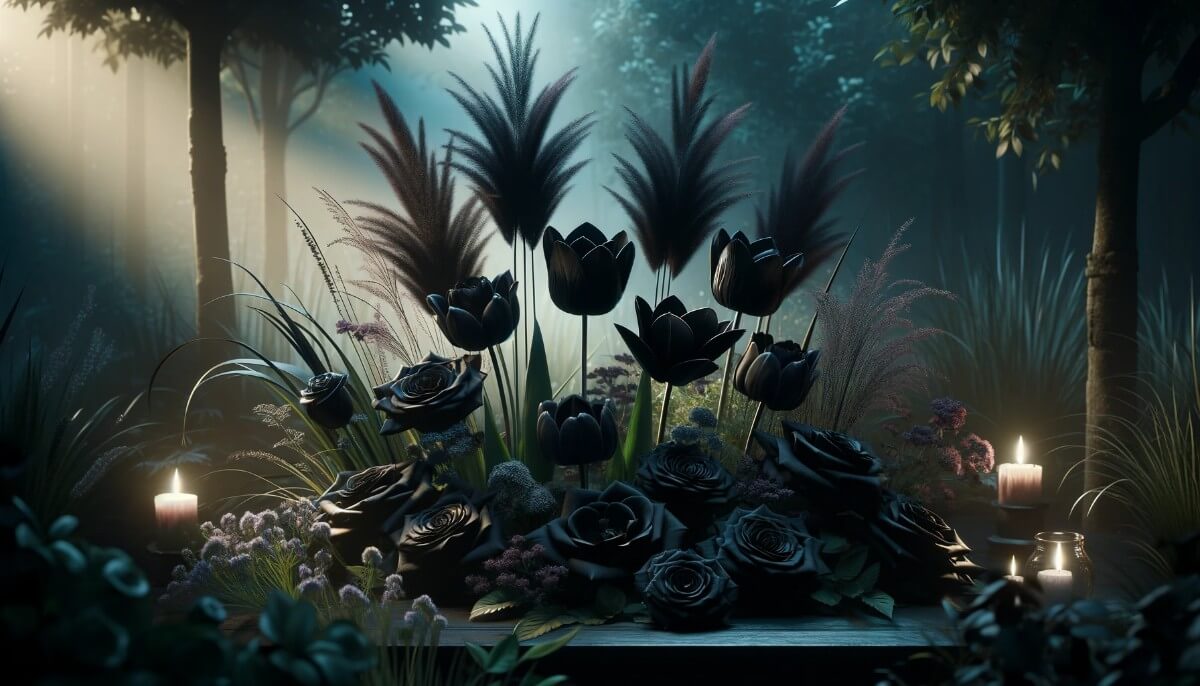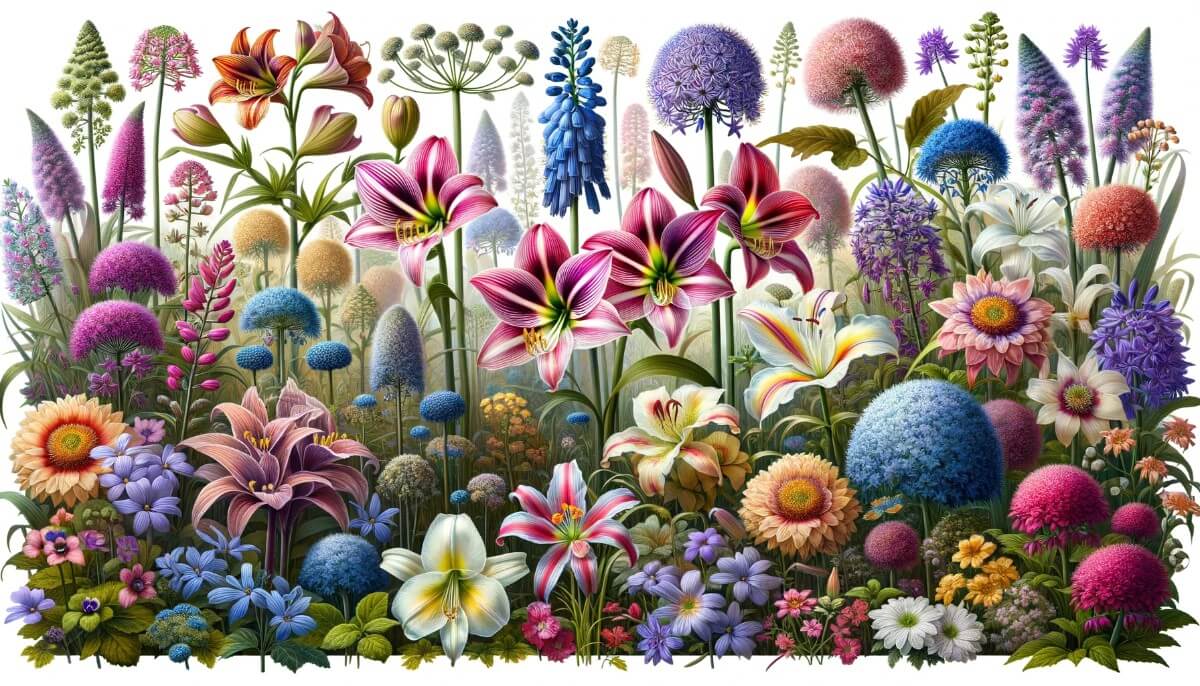In the realm of floriculture, black flowers hold a special mystique. They stand as nature’s sophisticated enigma, offering a unique blend of elegance and mystery. The spectrum ranges from deep purples to the darkest shades nearing black, each bloom holding within it a cosmos of quiet allure. This article unravels 20 enchanting dark blooms that grace the garden with their unorthodox beauty. From the haunting charm of the Black Hollyhock to the exotic aura of the Black Magic Elephant Ears, we delve into a garden of dark blossoms, each a testimony to nature’s endless palette. Through each flower, we explore the allure and mystique that black flowers bring to the verdant canvas of our gardens.
Black Mondo Grass: The Dark Gem of the Garden
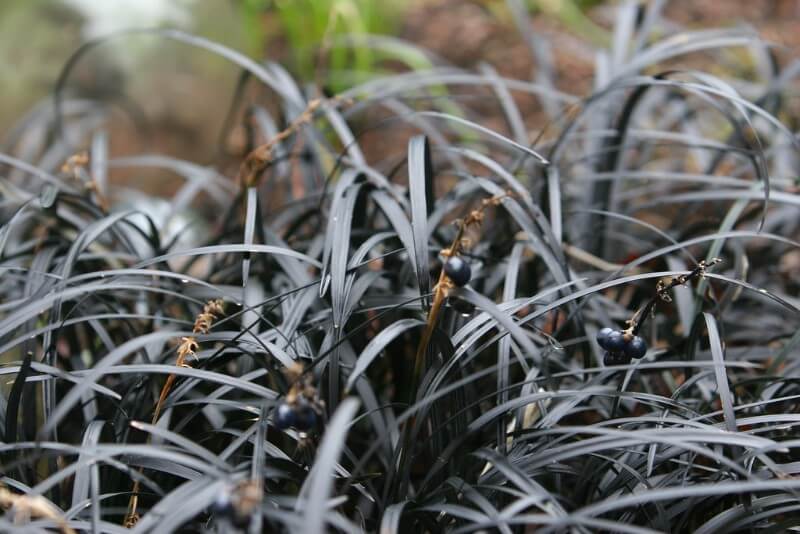
The Black Mondo Grass, or Ophiopogon planiscapus ‘Nigrescens’, is a mysterious yet elegant specimen, lending a touch of drama and contrast to any garden. Despite its name, it’s not truly a grass but a member of the lily family. Its dusky foliage, a dark purplish-black hue, emerges in tufts from the ground, creating a soft, almost velvet-like carpet that stands out stunningly against the green and bright colors commonly found in gardens.
This unique plant unfolds its beauty in an understated yet captivating manner. During summer, amidst the dark foliage, sprout delicate, bell-shaped, pinkish flowers on a solitary stalk, adding a subtle hint of color to its dark, leafy canvas. The play of color between the dark leaves and light blossoms makes Black Mondo Grass an enticing sight to behold.
| Family | Appearance | Origin | Blooming Season | Growth Habit | Size |
| Liliaceae | Dark purplish-black grass-like foliage with pink flowers | Asia | Summer | Perennial | About 8 inches tall |
Cultivating Black Mondo Grass requires a bit of patience and care, but the reward is a visually striking plant that provides a unique aesthetic. It thrives in well-draining, rich soil and appreciates deep watering every two to three weeks, especially during hot weather. It can endure both full sun and partially shaded areas, showcasing its versatility. The Black Mondo Grass doesn’t just stop at being a visual treat; its tuberous roots and easy-growing nature make it a practical choice for garden paths, rock gardens, and even as an ornamental ground cover, adding a dark elegance wherever it’s planted.
Tulipa ‘Queen of Night’: The Midnight Bloom
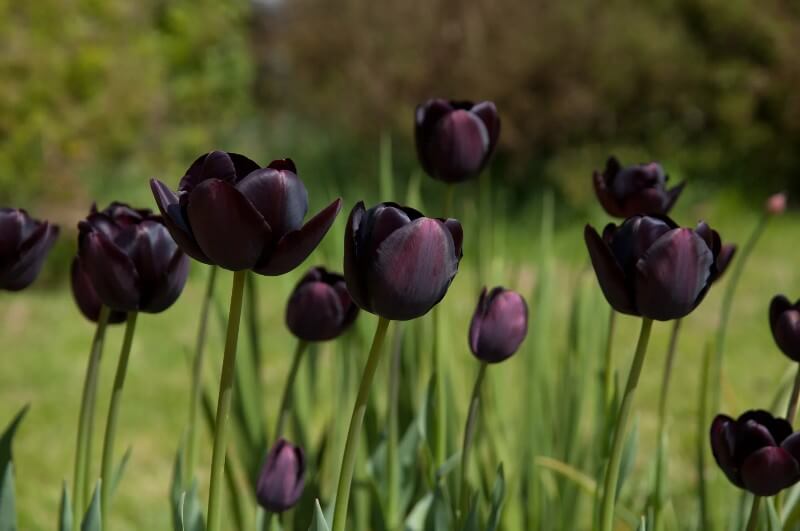
The Tulipa ‘Queen of Night’, a gem in the world of tulips, is often revered as the closest a flower might get to being truly black. Its lush, velvety blossoms are of a deep maroon or purple-black hue, exuding an air of mystery and elegance that’s rare and captivating. The contrast of these dark, almost black blooms against the green foliage is striking, making them a star of the late spring garden.
As the sun’s rays caress the petals of the ‘Queen of Night’, they seem to shimmer with a subtle, satiny sheen, adding to the flower’s allure. Their tall, sturdy stems lift them high, allowing them to sway gently with the breeze, creating a mesmerizing dance of dark silhouettes against the daylight.
| Family | Appearance | Origin | Blooming Season | Growth Habit | Size |
| Liliaceae | Deep maroon to purple-black tulip blooms on tall, sturdy stems | Cultivar | Late Spring | Perennial | About 20-24 inches tall |
Cultivating Tulipa ‘Queen of Night’ is a journey into the dramatic. They thrive in well-drained soil and full sun, although they appreciate some afternoon shade in warmer climates. A fair amount of watering and a bit of patience will lead to a garden graced with the dark, rich blooms of the ‘Queen of Night’, a sight that’s bound to captivate anyone with a love for the unique and beautiful. The ‘Queen of Night’ tulip isn’t just a flower; it’s a statement, a bold declaration of nature’s ability to surprise, enchant, and evoke emotion.
Helleborus ‘Midnight Ruffles’: The Midnight Whisperer
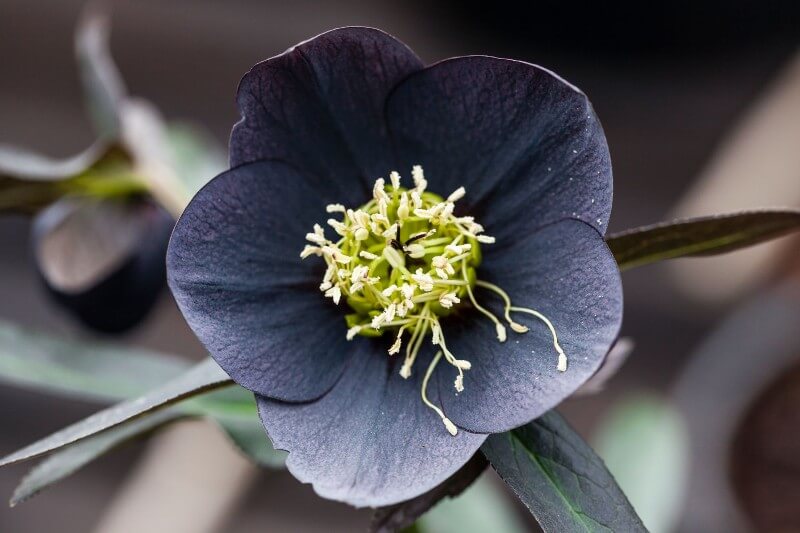
The Helleborus ‘Midnight Ruffles’ is a whimsical charmer, extending an invitation to a moonlit garden romance with its deeply ruffled, near-black blossoms. Nestled amidst rich, green foliage, these dark, velvety flowers create a serene yet dramatic display, akin to the quiet whispers of the midnight hour.
As the soft ruffles unfold in late winter to early spring, they reveal a complex tapestry of dark hues, sometimes kissed with a hint of purple or burgundy, embracing the fading chill in the air. The delicate, nodding heads of ‘Midnight Ruffles’ seem to hold ancient, poetic secrets, waiting to be discovered by those who wander through the garden under the soft glow of the moon.
Here is a brief overview of the Helleborus ‘Midnight Ruffles’ botanical characteristics:
| Family | Appearance | Origin | Blooming Season | Growth Habit | Size |
| Ranunculaceae | Near-black, ruffled blossoms amidst rich, green foliage | Hybrid Cultivar | Late Winter to Early Spring | Perennial | 18 to 24 inches in height |
The cultivation of ‘Midnight Ruffles’ is a venture into the quaint and mystical. They thrive in well-drained, fertile soil, and prefer partial to full shade, making them a suitable choice for those shady, quiet corners of the garden. Moderate watering and a sheltered spot will reward the gardener with a display that’s both serene and captivating, a reflection of the quiet beauty that nature often whispers amid the hustle of life. Helleborus ‘Midnight Ruffles’ is more than just a plant; it’s a gentle reminder of the quiet, unassuming beauty that often lies hidden in plain sight, waiting for a discerning eye to discover and cherish.
The Black Baccara Rose
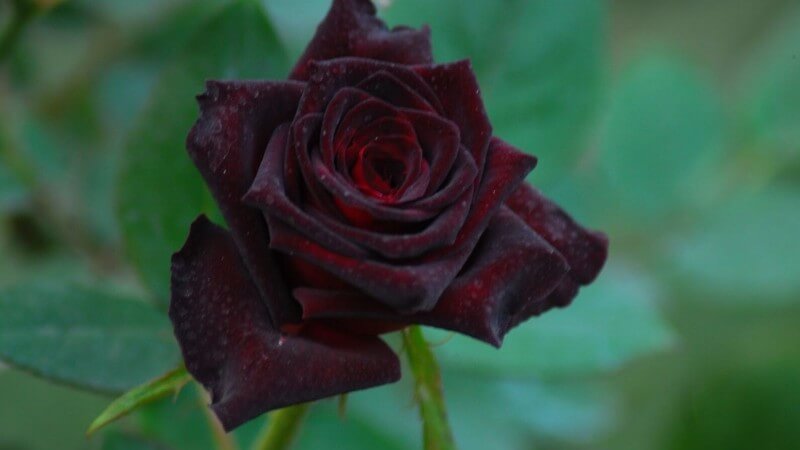
The Black Baccara Rose is a seductive enigma, its deep maroon to almost black blooms are a rare and exquisite sight in the realm of roses. Each petal seems to hold a dark, velvet mystery, with hues reminiscent of a hauntingly beautiful midnight sky. The opulent petals are rich and thick, cupping a subtle, sweet fragrance that whispers secrets of love and mystery.
With the first light of dawn, the Black Baccara Rose emerges from its green foliage, a dark jewel in the heart of the garden. Its long, sturdy stems reach out towards the sky, each one crowned with a blossom that speaks the language of love, romance, and timeless elegance.
| Family | Appearance | Origin | Blooming Season | Growth Habit | Size |
| Rosaceae | Deep maroon to almost black blooms on long, sturdy stems | Hybrid | Late Spring to Early Summer | Perennial | Up to 3-4 feet in height |
Cultivating the Black Baccara Rose is a pledge to elegance and a timeless beauty. They flourish in well-drained soil, under the tender kisses of the morning sun, with a moderate amount of water to quench their thirst. They are a garden’s treasure, offering their dark, plush blossoms not only as a visual delight but also as a unique, dramatic addition to bouquets and floral arrangements.
The Black Baccara Rose isn’t merely a flower; it is an emotion, a dark yet tender expression of nature’s boundless imagination, a symbol of love that’s deep, passionate, and wrapped in layers of beautiful mystery. Each bloom is a narrative, a story waiting to be told, a journey waiting to be taken, into the deep, tender mysteries of life and love.
The Blacknight Hollyhock
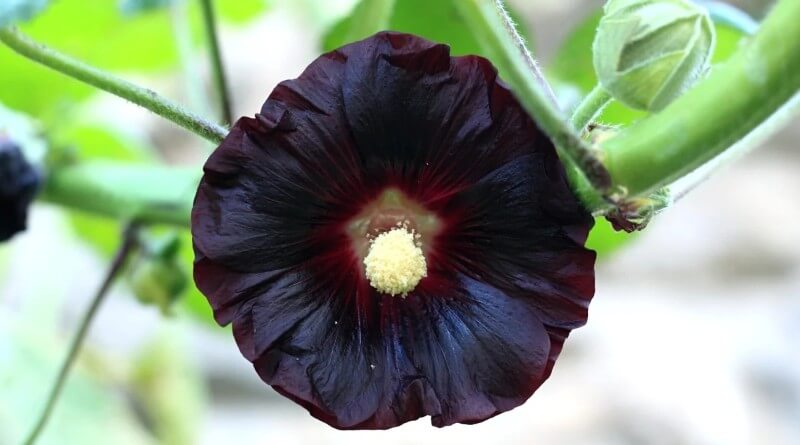
The Blacknight Hollyhock stands tall and dignified, a sentinel of the garden with its towering spikes adorned with dark purple to almost black blooms. Each flower is a dark jewel, its satiny petals unfolding against the canvas of the sky, declaring the mysteries of the night in the light of day.
As the summer breeze wanders through the garden, it whispers tales to the Blacknight Hollyhock, making its tall spikes sway gently, creating a dance of dark silhouettes against the soft hues of the dawn and dusk. This old garden favorite doesn’t just stand tall in stature but also in spirit, its presence is a blend of the ancient and the modern, a touch of wildness amidst the cultivated, a nod to the gardens of yore.
| Family | Appearance | Origin | Blooming Season | Growth Habit | Size |
| Malvaceae | Dark purple to black blooms on tall spikes, each flower a silhouette against the garden’s palette | Eurasia | Summer | Perennial | Up to 8 feet tall |
Cultivating the Blacknight Hollyhock is akin to bringing a piece of history into your garden. They thrive in well-draining soil, basking under the full sun, their faces turned towards the sky as if reminiscing tales of the gardens of the past. A modest amount of care, a touch of love, and a whisper of patience will gift you a garden graced with the towering spikes of Blacknight Hollyhock, each one telling tales of the night under the soft glow of the day.
Arabian Night Dahlia (Dahlia ‘Arabian Night’): The Velvet Nightfall
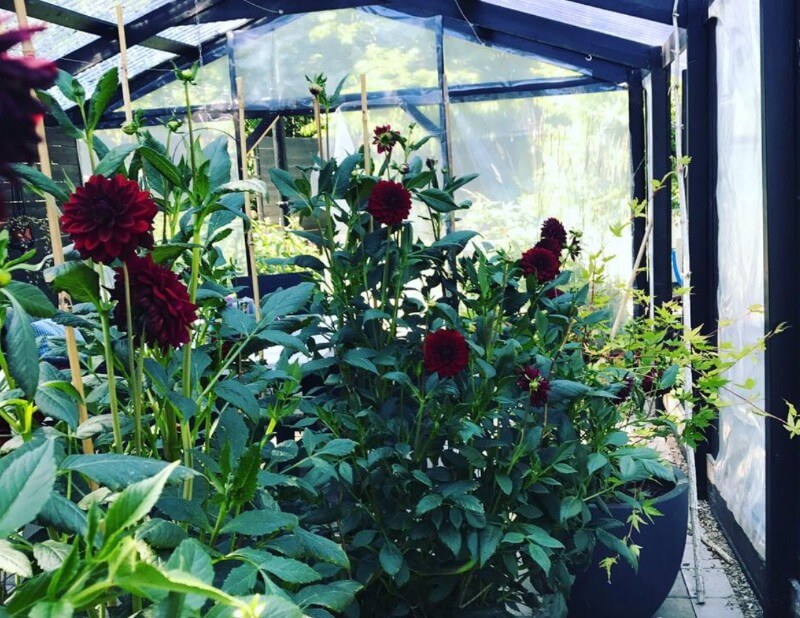
The Arabian Night Dahlia is a mesmerizing spectacle of nature, its deep purple-red flowers resembling the rich, velvet drapes of the night sky as it adorns the garden with a touch of royalty. The almost black blooms are a haven of mystery and allure, each petal holding whispers of tales from Arabian nights, where magic dances in the moonlight and echoes through the cool breeze of the garden.
As the sun casts its warm, golden rays, the dark blossoms of the Arabian Night Dahlia seem to hold within them, the secrets of the night, sharing with the day, tales of magic, love, and adventure. Their full, rounded blooms are a sight of elegance, a dark contrast against the vibrant palette of a blooming garden, adding a touch of the exotic to the familiar.
| Family | Appearance | Origin | Blooming Season | Growth Habit | Size |
| Asteraceae | Deep purple-red to almost black blooms with a velvety texture | Hybrid | Summer to Fall | Perennial | Up to 4 feet in height |
Cultivating the Arabian Night Dahlia is an invitation to a garden filled with stories and adventures. They flourish in well-drained soil, basking under the full sun, their dark blooms a mesmerizing sight as they sway gently with the breeze, sharing whispers of faraway lands and tales of magic with every passerby. Each bloom is a narrative, a journey into the heart of a mystical night where stars tell tales and the moon sings the songs of the old, a garden where every evening is an Arabian night, waiting to unfold its tales to those who seek them.
Chocolate Cosmos (Cosmos atrosanguineus): The Sweet Serenade
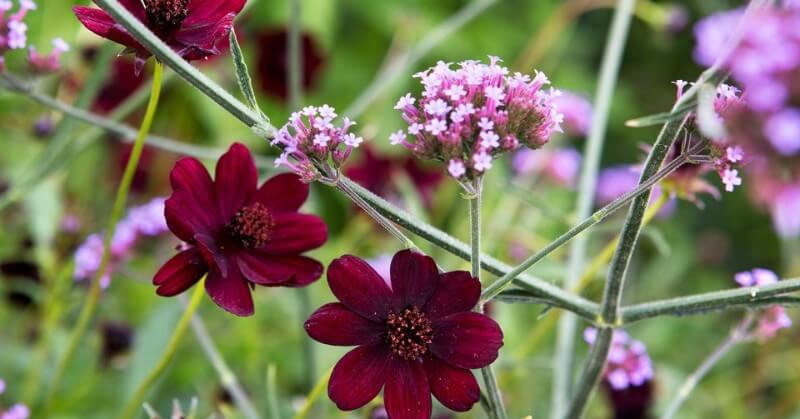
The Chocolate Cosmos is nature’s sweet serenade, a melody of dark beauty sung in whispers of cocoa. Each bloom is a dark enchantment, its maroon-dark brown petals unfolding in a gentle display reminiscent of twilight’s soft embrace. But the allure of Chocolate Cosmos goes beyond sight, venturing into the realm of scent with a light vanillin fragrance that wafts through the garden, a sweet aroma reminiscent of the finest chocolate.
As the day unfolds, the fragrance of Chocolate Cosmos becomes more pronounced, its sweet notes mingling with the cool evening air, creating an atmosphere of calm and gentle allure. The modest size of the blooms, nestled amidst lush green foliage, belies the grandeur of its beauty and the sweetness of its scent, making it a humble yet captivating addition to any garden.
| Family | Appearance | Origin | Blooming Season | Growth Habit | Size |
| Asteraceae | Dark red to maroon-dark brown flowers with a light vanillin fragrance | Mexico | Summer to Fall | Perennial | Up to 2-3 feet in height |
Cultivating Chocolate Cosmos is like crafting a poem, a sweet ode to the gentle mysteries of nature. They thrive in well-drained soil, under the tender caress of the sun, their blooms a dark contrast against the bright canvas of the garden. A touch of care, a whisper of love, and the Chocolate Cosmos will reward you with a garden filled with the sweet aroma of chocolate, a gentle reminder of nature’s boundless creativity and love for the whimsical.
Viola ‘Molly Sanderson’: The Midnight Bloom
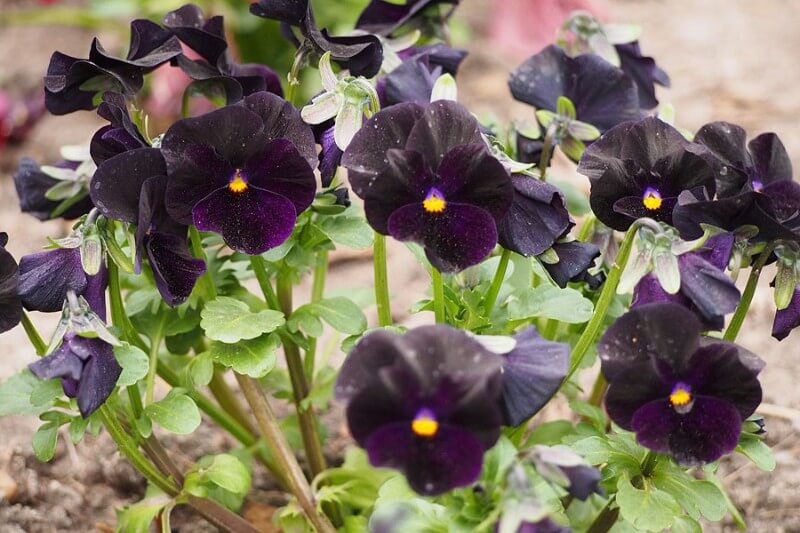
Viola ‘Molly Sanderson’ is a harbinger of delicate beauty amidst the robust colors of the garden. Its dark, almost black flowers are like whispers of the night sky, nestled softly among its green foliage. Each bloom is a modest, yet profound statement of elegance, its dark hue creating a beautiful contrast against the vibrant tableau of a blooming garden.
The delicate whispers of ‘Molly Sanderson’ continue from late spring through summer, offering a serene, almost poetic respite from the bustling colors of the warmer seasons. The blooms may be small, but they hold within them a depth of color and beauty that is captivating.
| Family | Appearance | Origin | Blooming Season | Growth Habit | Size |
| Violaceae | Near-black flowers amidst lush green foliage | Cultivar | Late Spring to Summer | Perennial | Compact, up to 6-8 inches in height |
Cultivating the Viola ‘Molly Sanderson’ is like penning a soft, tender poem amidst the bold verses of the garden. It thrives in a variety of conditions, showcasing its modest beauty in both sun and partial shade. A little care, a touch of love, and ‘Molly Sanderson’ will grace your garden with its quiet, understated elegance, reminding you of the gentle whispers of beauty that softly echo through the chaos of life.
Iris ‘Before the Storm’: The Quiet Prelude
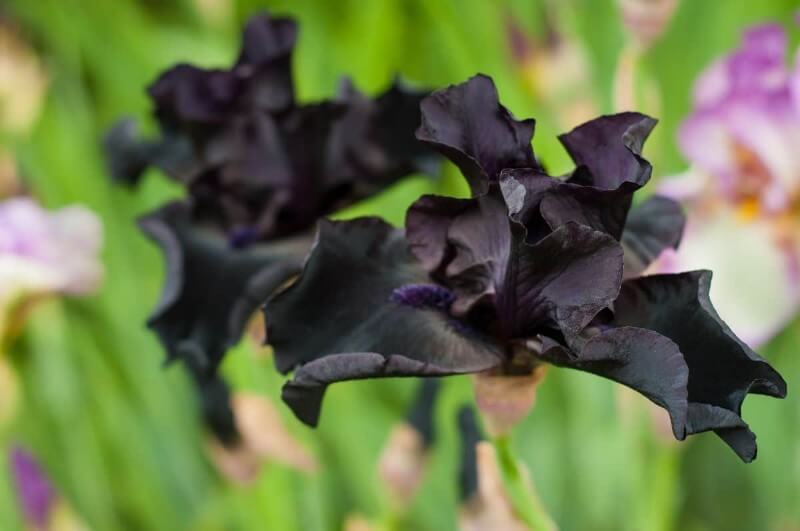
Iris ‘Before the Storm’ is a whisper of the enigmatic, its dark purple to almost black blooms standing as quiet sentinels awaiting the dramatic unfoldings of nature. Each bloom is a rich tapestry of dark hues, reminiscent of the quiet yet charged atmosphere that pervades the skies before a storm. With grey-green sword-like leaves, they bear a stoic grace, their dark blooms a quiet prelude to the dramatic dance of a storm.
As the season transitions from spring to early summer, ‘Before the Storm’ unveils its beauty, the dark blossoms emerging as silent narratives of the cycles of nature. The sight of these dark blooms against the bright palette of a blossoming garden evokes a sense of mystery and anticipation, much like the quiet before a storm.
| Family | Appearance | Origin | Blooming Season | Growth Habit | Size |
| Iridaceae | Dark purple to black flowers with grey-green, sword-like leaves | Cultivar | Late Spring to Early Summer | Perennial | About 2-3 feet in height |
Cultivating Iris ‘Before the Storm’ is an invitation to embrace the quiet, the mysterious, and the dramatic unfoldings of nature. They thrive in well-drained soil, basking in the full sun to partial shade. Their modest needs and striking appearance make them a captivating choice for gardeners seeking to add a touch of drama and mystery to their gardens. Each bloom stands as a silent narrative, a reminder of the quiet beauty that often precedes the dramatic displays of nature, a homage to the quiet before the storm.
Chocolate Lily (Fritillaria camschatcensis): The Earthly Confection
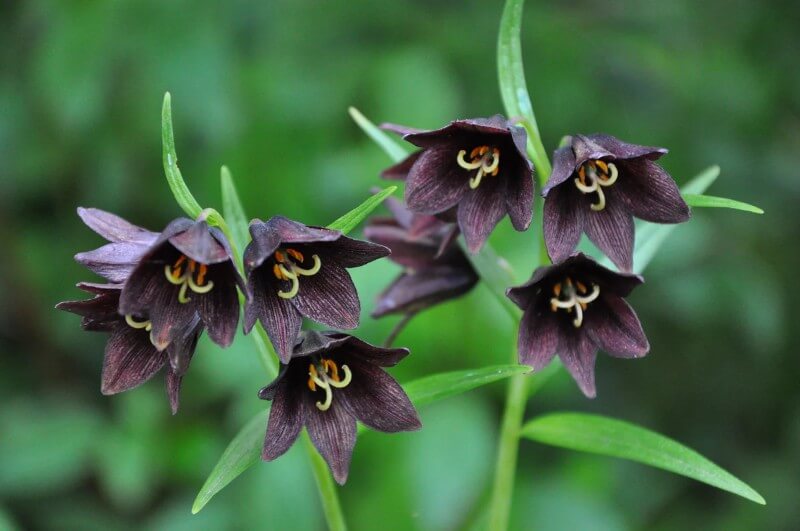
The Chocolate Lily, with its unique dark greenish-brown to brownish-purple flowers, stands as a quaint echo of nature’s whimsy. The drooping bell-shaped blooms, reminiscent of chocolate in color and name, are nature’s earthly confection amidst a field of green. From May to July, these peculiar blooms emerge, lending a touch of the unusual and the exotic to the garden’s tableau.
Though not as sweet as its name might suggest, the Chocolate Lily has a peculiar charm. It’s a member of the lily family, but with a touch of the wild, its color a rare spectacle in the array of garden blooms. However, it holds a secret—unlike the sweet allure of chocolate, the blooms have a foul smell to attract its pollinators, flies.
| Family | Appearance | Origin | Blooming Season | Growth Habit | Size |
| Liliaceae | Dark greenish-brown to brownish-purple flowers, bell-shaped blooms | North America, Asia | May to July | Perennial | 8-24 inches in height |
Cultivating the Chocolate Lily is an adventure into the peculiar. It thrives in well-draining, fertile soil under the full sun to partial shade. Its whimsical appearance and unique pollination strategy make it a conversation starter, a small mystery waiting to be discovered in the heart of the garden. The Chocolate Lily is a poetic reminder of nature’s endless imagination, its ability to surprise, and the hidden stories that lie in the heart of a garden, waiting to be discovered by the curious heart.
Black Hollyhock (Alcea rosea ‘Nigra’): The Dark Elegance
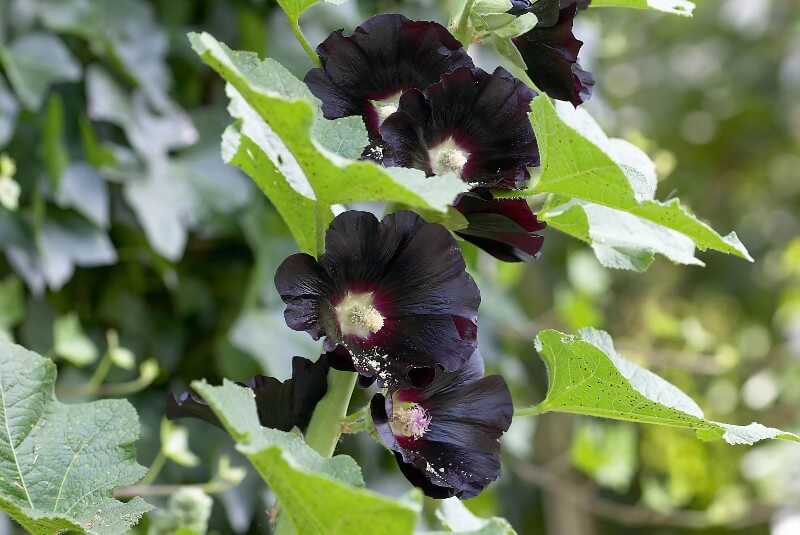
The Black Hollyhock, with its towering spires of near-black blossoms, stands as a regal presence in the garden. Its satiny flowers, deep maroon to almost black in hue, unfold elegantly against the sky, each petal catching the light in a soft, subtle sheen. Amidst a garden bustling with colors, the Black Hollyhock is a quiet but striking statement of elegance and mystery.
The tall stalks of Alcea rosea ‘Nigra’ rise high, holding aloft the dark blooms that appear from late spring to mid-summer. They stand as silent sentinels, their dark hues a beautiful contrast to the green foliage and a unique companion to the bright blooms that share its garden home.
| Family | Appearance | Origin | Blooming Season | Growth Habit | Size |
| Malvaceae | Near-black, satiny blooms on tall, sturdy stalks | Cultivar | Late Spring to Mid-Summer | Perennial | Up to 8 feet tall |
Cultivating the Black Hollyhock is a venture into the dramatic. They thrive in well-drained soil under the gentle warmth of the full sun. A little care, a touch of love, and the Black Hollyhock will grace your garden with its dark, elegant blooms, creating a landscape that whispers tales of the old-world charm, mystery, and the timeless dance of light and dark in the heart of nature. Each bloom is a narrative, a journey into the quiet, elegant beauty that lies in contrast and simplicity, a reminder of the endless palette of colors that nature paints with, creating a garden of endless possibilities and whispers of tales yet untold.
Diabolo Ninebark (Physocarpus opulifolius ‘Diabolo’): The Dark Foliage Spectacle
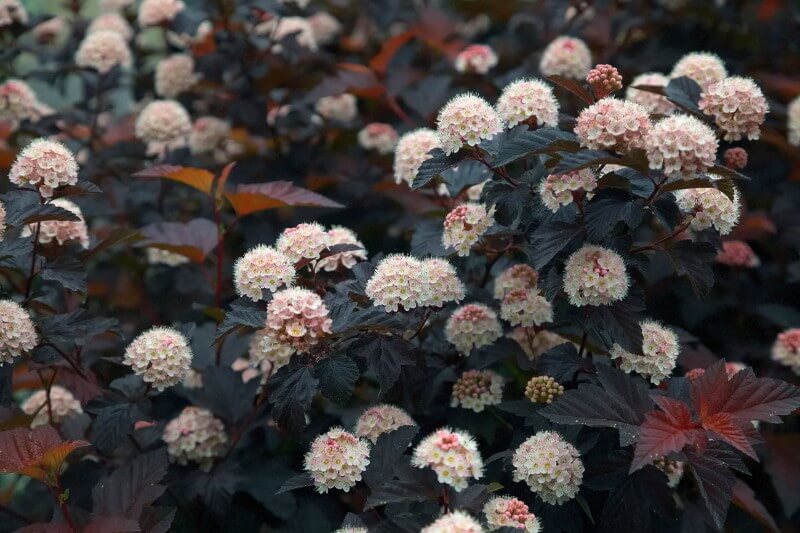
Diabolo Ninebark is a riveting display of dark foliage in the garden landscape. Its deep purple to almost black leaves create a dramatic backdrop, against which the bright blossoms of other garden denizens shine even brighter. The small, spirea-like pinkish-white flowers that bloom in late spring to early summer add a soft contrast to the dark foliage, creating a visual spectacle that captivates the senses.
As a hardy deciduous shrub, Diabolo Ninebark stands strong through various seasons, its peeling bark revealing layers of color and texture that add a unique charm even in the barren winters. The arching branches create a fountain-like silhouette, a dark cascade that adds depth and drama to the garden’s scenery.
| Family | Appearance | Origin | Blooming Season | Growth Habit | Size |
| Rosaceae | Deep purple to almost black leaves with pinkish-white flowers | Cultivar | Late Spring to Early Summer | Deciduous Shrub | Up to 8 feet tall and wide |
Cultivating Diabolo Ninebark is an endeavor into creating a garden that speaks volumes through contrasts and textures. It thrives in a variety of soil conditions and is tolerant of drought once established, showcasing a resilient charm. Its preference for full sun allows the dark foliage to attain its richest color. The Diabolo Ninebark is not just a plant; it’s an expression of the mysterious and the dramatic in nature, a dark foliage spectacle that tells tales of resilience and beauty amid the ever-changing canvas of the garden. Through every leaf, branch, and bloom, Diabolo Ninebark adds a touch of the enigmatic, drawing the eye and capturing the heart of every garden admirer.
Weigela ‘Wine and Roses’ (Weigela florida ‘Alexandra’ Wine and Roses): The Blossoming Vino
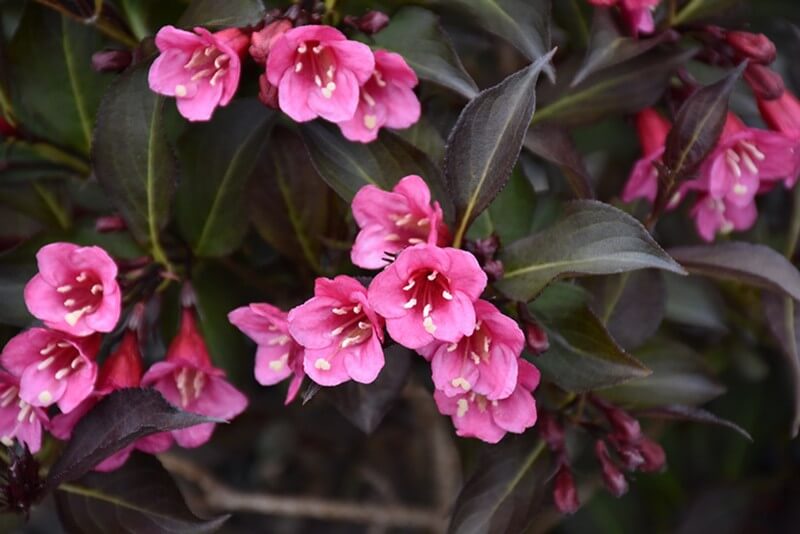
Weigela ‘Wine and Roses’ paints a picturesque scene in the garden with its intoxicating deep rose-pink flowers against a backdrop of dark burgundy-purple foliage. Each bloom is a delicate sip of wine, a sweet nectar for the visiting hummingbirds, set against leaves reminiscent of a rich, velvety wine.
As the seasons transition from late spring to early summer, the garden is awash with the ‘Wine and Roses’ vibrant blossoms, creating a visual tapestry that mimics a fine wine blending with the soft notes of a rose. The contrast between the dark leaves and bright flowers creates a dramatic visual effect, a dance of color that celebrates the essence of a blossoming vino.
| Family | Appearance | Origin | Blooming Season | Growth Habit | Size |
| Caprifoliaceae | Dark burgundy-purple leaves with deep rose-pink flowers | Cultivar | Late Spring to Early Summer | Deciduous Shrub | Up to 4-5 feet tall and wide |
Cultivating the Weigela ‘Wine and Roses’ is akin to composing a visual symphony where every bloom is a note of joy and every leaf, a melody of elegance. It thrives in well-drained soil under the full sun, where the true richness of its colors shines through, creating a breathtaking display. The ‘Wine and Roses’ is not just a shrub; it’s a festival of color, an ode to the beauty that unfolds with every blossom, reminding one of the sweet communion between nature and the senses. Through each season, it stands as a reminder of the joy of color and the sweet nectar of life that blooms in the heart of a garden.
Black Beauty Elderberry (Sambucus nigra ‘Black Beauty’): The Dark Enchantress
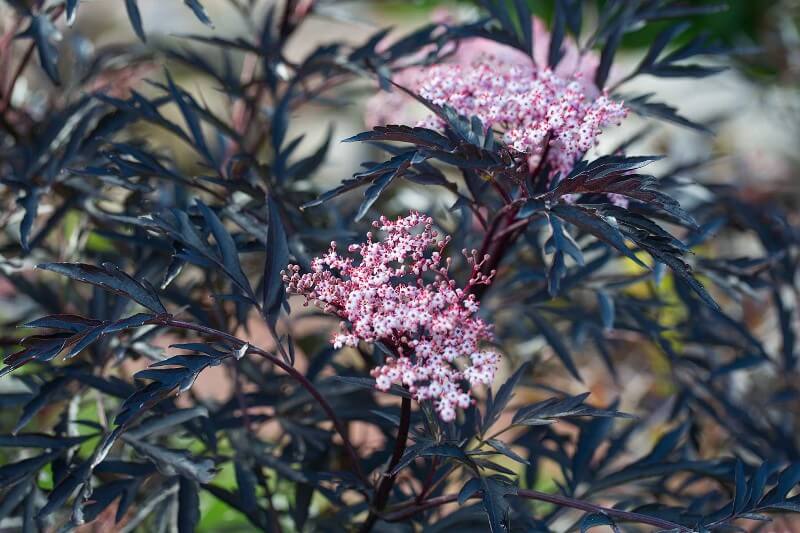
The Black Beauty Elderberry is a spectacle of dark elegance in the garden. Its deep purple-black foliage creates a rich and dramatic backdrop against which its pink, muscat-scented blossoms bloom in a soft, ethereal contrast. As summer unfolds, the delicate flowers give way to blackish red berries, a treasure trove for birds and a lovely ingredient for jams and wines.
As the leaves flutter gently in the breeze, the Black Beauty Elderberry appears like a dark enchantress whispering ancient tales. Its presence in the garden is not just a visual delight but an invitation to a sensory exploration – the soft rustle of leaves, the sweet scent of blossoms, and the melody of birds drawn to its berries.
| Family | Appearance | Origin | Blooming Season | Growth Habit | Size |
| Adoxaceae | Dark purple-black foliage with pink, muscat-scented flowers | Cultivar | Late Spring to Early Summer | Deciduous Shrub | Up to 6-8 feet tall and wide |
Cultivating the Black Beauty Elderberry is a journey into the heart of nature’s contrasts and harmonies. It flourishes in well-drained soil under the full sun to partial shade, its colors deepening with the warmth of the sun. The Black Beauty Elderberry is not just a plant; it’s an experience, a dance of color, scent, and sound that unfolds with the seasons, adding a rich narrative to the garden’s tale. Through every leaf, flower, and berry, it echoes the timeless beauty and bounty of nature, a dark enchantress that enchants the senses and enriches the garden’s ecosystem.
Black Mondo Grass (Ophiopogon planiscapus ‘Nigrescens’): The Midnight Carpet

The Black Mondo Grass, with its tufts of dark, almost black foliage, lends a mysterious yet elegant demeanor to the garden. Despite being referred to as grass, it belongs to the lily family and showcases a soft, almost velvet-like carpet of dark leaves that starkly contrast against the more common greens and bright colors in a garden.
The beauty of Black Mondo Grass unfolds in a subtle yet captivating manner. In summer, amidst the dark foliage, delicate, bell-shaped, lilac flowers emerge on a solitary stalk, adding a gentle touch of color to the dark, leafy canvas. The play of color between the dark leaves and light blossoms makes the Black Mondo Grass a fascinating sight.
| Family | Appearance | Origin | Blooming Season | Growth Habit | Size |
| Liliaceae | Dark purplish-black grass-like foliage with lilac flowers | Asia | Summer | Perennial | About 8 inches tall |
Cultivating Black Mondo Grass is an act of embracing the mystique in nature. It thrives in well-draining, rich soil and appreciates a deep watering every two to three weeks, especially during hot weather. It endures both full sun and partially shaded areas, showcasing its versatility. The Black Mondo Grass doesn’t just stop at being a visual treat; its tuberous roots and easy-growing nature make it a practical choice for garden paths, rock gardens, and as an ornamental ground cover, adding a touch of dark elegance wherever it is planted. Through its unique color and gentle blossoms, the Black Mondo Grass invites a quiet exploration of the beauty inherent in contrast and the serene whispers of nature’s mystique.
Zwartkop Aeonium (Aeonium arboreum ‘Zwartkop’): The Dark Rosettes
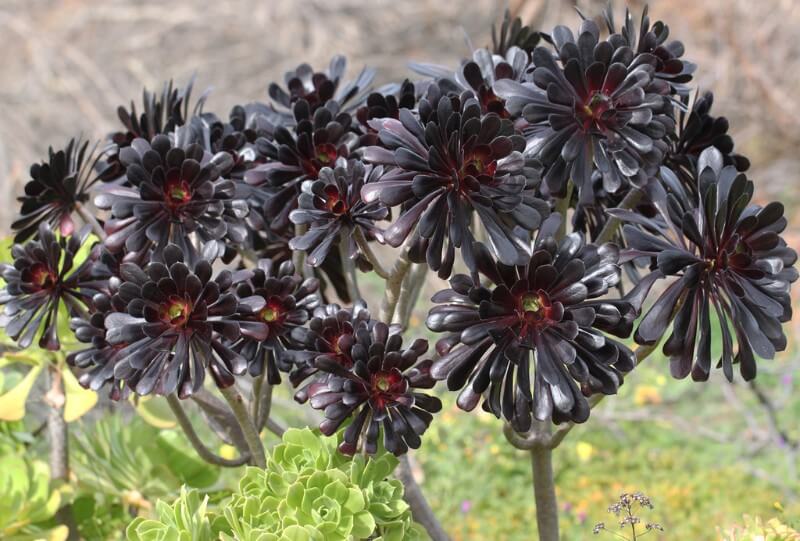
The Zwartkop Aeonium, with its rosettes of deep burgundy to almost black leaves, stands as a striking silhouette in the garden. The dark, glossy foliage arranged in perfect rosettes creates a dramatic contrast against the brighter greens and colors commonly found in the garden tapestry.
As the seasons transition, the ‘Zwartkop’ remains a visual delight, its dark rosettes thriving against the clear skies. In late winter to early spring, bright yellow flowers emerge on tall stems, juxtaposed against the dark foliage, creating a visual spectacle that celebrates the contrasts of nature.
| Family | Appearance | Origin | Blooming Season | Growth Habit | Size |
| Crassulaceae | Deep burgundy to almost black leaf rosettes | Cultivar | Late Winter to Early Spring | Succulent | Up to 3 feet in height |
Cultivating the Zwartkop Aeonium is a venture into the bold and beautiful. It thrives in well-draining soil under the gentle warmth of full sun to partial shade. Being a succulent, it has modest water needs, making it a beautiful yet low-maintenance choice for gardeners. The Zwartkop Aeonium is not just a plant; it’s a statement, a bold declaration of nature’s ability to craft beauty in bold contrasts. Each rosette is a narrative of resilience, a reminder of the beauty that lies in the heart of contrasts, and the mesmerizing stories that unfold when the bright and the dark come together in a dance of nature.
Canna ‘Black Tropicanna’ (Canna indica): The Tropical Noir
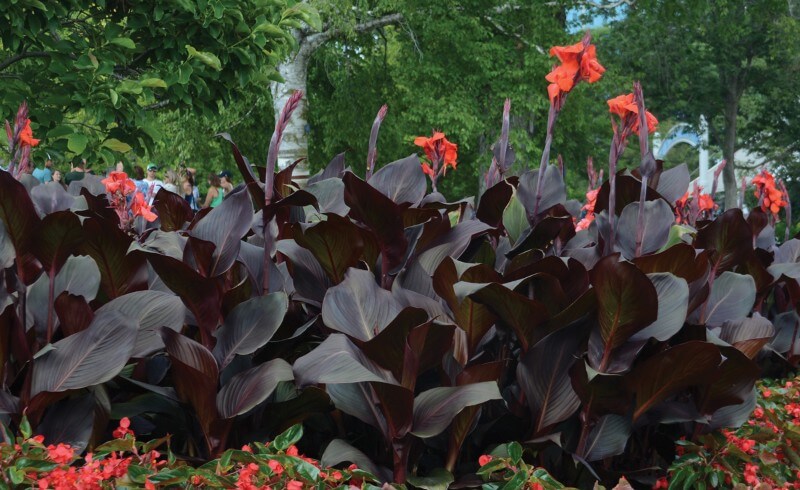
The Canna ‘Black Tropicanna’ is a visual voyage into the heart of a tropical night. Its dark, burgundy to almost black foliage unfolds in a dramatic display, each leaf a statement of elegance and mystery. The leaves themselves are a spectacle, but when the bright orange to red flowers burst forth in summer, it’s a fiery display of color against the dark foliage, evoking the vibrant spirit of tropical lands.
As the sun casts its warm rays, the dark foliage seems to shimmer with a subtle, mysterious sheen, while the flamboyant flowers reach out for the sky, creating a mesmerizing contrast that captivates the senses.
| Family | Appearance | Origin | Blooming Season | Growth Habit | Size |
| Cannaceae | Dark burgundy to almost black foliage with bright orange to red flowers | Cultivar | Summer | Perennial | Up to 6 feet in height |
Cultivating Canna ‘Black Tropicanna’ is an invitation to a garden filled with dramatic contrasts and tropical allure. They flourish in well-drained, fertile soil and revel under the full sun, their vibrant blooms a celebration of light, while their dark leaves whisper the mysteries of the night. A moderate amount of water and a touch of patience will reward the gardener with a display that’s both exotic and captivating, a reminder of nature’s boundless imagination and the enchanting dance of color that unfolds in the heart of a garden. The ‘Black Tropicanna’ Canna isn’t just a flower; it’s an experience, a journey into the heart of a tropical night where every leaf tells tales of mystery and every bloom sings songs of joy.
Black Magic Elephant Ears (Colocasia esculenta ‘Black Magic’): The Enchanted Canopy
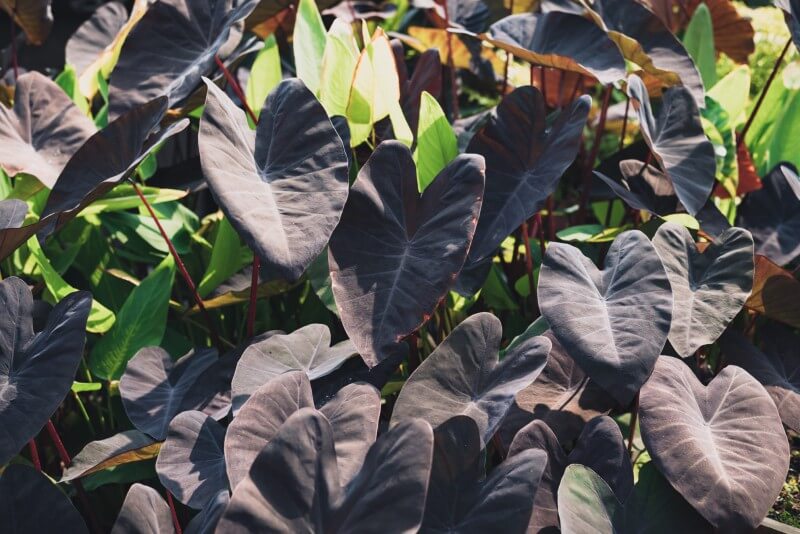
The Black Magic Elephant Ears are an entrancing presence in the garden, with their gigantic, heart-shaped leaves of a deep purple to almost black hue. Each leaf is a spectacle, a dark canopy under which the magic of the garden seems to thrive. As they flutter gently in the breeze, the leaves of the Black Magic Elephant Ears create a dance of shadows and light, a mystical ballet that adds a touch of enchantment to the garden.
The dramatic foliage is not just a visual delight but an exploration into the mysterious and the whimsical. In a garden bathed in sunlight, the dark leaves of the Black Magic Elephant Ears stand as a cool, serene retreat, their dark hues a soothing contrast to the vibrant colors around.
| Family | Appearance | Origin | Blooming Season | Growth Habit | Size |
| Araceae | Deep purple to almost black, large heart-shaped leaves | Cultivar | Summer | Perennial | Up to 3-6 feet in height and width |
Cultivating the Black Magic Elephant Ears is a venture into the whimsical. They thrive in moist, well-draining soil and revel in the warm embrace of the sun or the gentle shade. Their modest needs are a humble request for the grand display of foliage they offer in return. The Black Magic Elephant Ears are not just a plant; they are an invitation to a realm where magic dwells in every leaf, and mystery whispers through the rustle of the dark foliage. Each leaf is a story, a tale of nature’s boundless imagination, and a reminder of the enchantment that lies in the heart of a garden, waiting to be discovered by those who wander and wonder.
Black Prince Coleus (Solenostemon scutellarioides ‘Black Prince’): The Royal Velvet
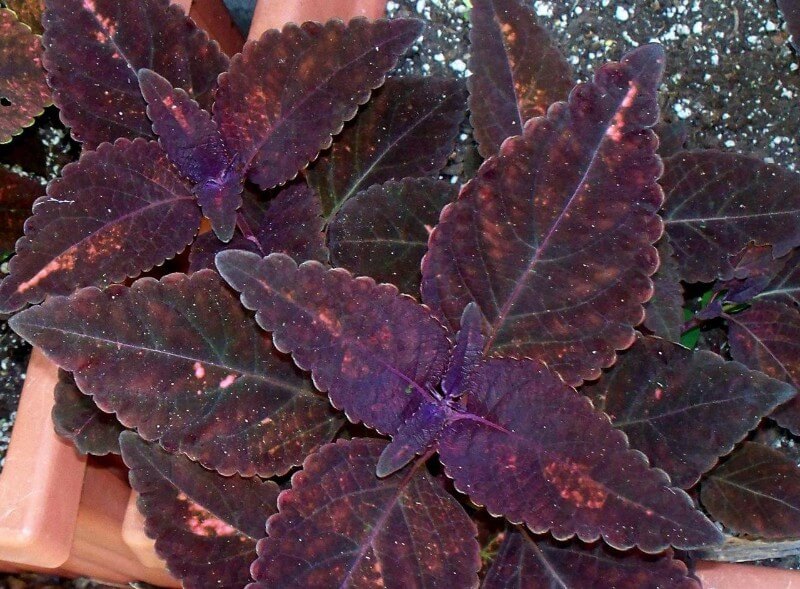
The Black Prince Coleus graces the garden with a regal presence, its dark burgundy to almost black foliage unfolding in a soft, velvety display. Each leaf is a rich tapestry of color, the dark hues highlighted by occasional flashes of bright colors at the edges or veins, creating a visual feast of contrast and drama.
The serrated leaves of the Black Prince Coleus form a lush, dense canopy, creating a luxurious texture that beckons to be touched. As light filters through the foliage, it creates a play of shadows and light, a dynamic display that adds a touch of the mysterious and the luxurious to the garden.
| Family | Appearance | Origin | Blooming Season | Growth Habit | Size |
| Lamiaceae | Dark burgundy to almost black, serrated, velvety foliage | Cultivar | Late Summer to Fall | Perennial | Up to 2 feet in height and width |
Cultivating the Black Prince Coleus is akin to adding a touch of royal velvet to the garden. It thrives in well-draining soil under partial shade to full sun, its colors deepening with more light. The modest water needs and easy-going nature of the Black Prince Coleus make it a delightful companion for gardeners. It’s not just a plant; it’s a royal statement, a luxurious touch to the garden landscape that celebrates the richness and diversity of nature’s palette. Through every season, the Black Prince Coleus stands as a reminder of the lavish beauty that nature bestows upon those who seek it, adding a touch of the extraordinary to the everyday garden.
Iolanthe (Black Magnolia): The Dark Bloom Enigma
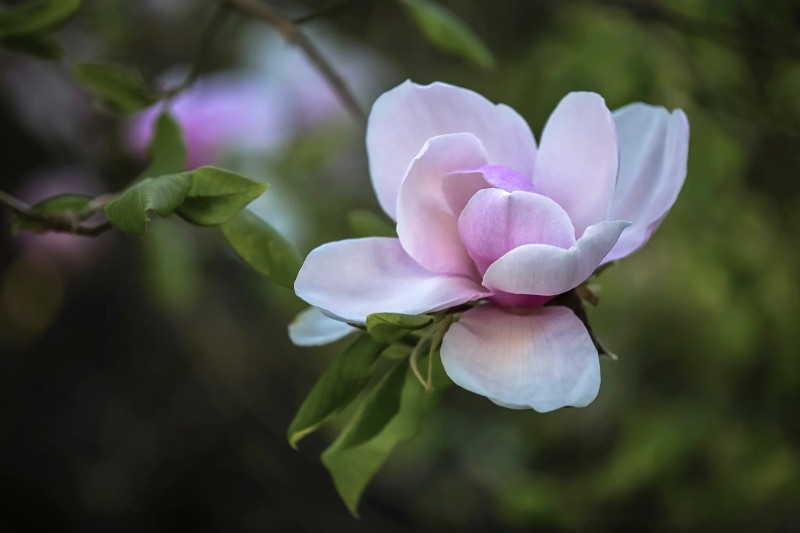
The Iolanthe, commonly known as the Black Magnolia, is a captivating enigma in the garden, its dark, almost black buds unraveling into large, luxurious blooms of deep plum to nearly black hue. Each blossom is a dark jewel amid the verdant foliage, unfurling gently to reveal a contrasting light interior, creating a dramatic visual spectacle that celebrates the mysteries of nature.
As the blooms of the Black Magnolia grace the garden, they unfold a narrative of elegance and mystery, their dark hues a beautiful contrast to the bright palette of the garden. The soft, sweet scent that drifts from the blooms adds an aura of mystique, making the garden a realm of sensory exploration.
| Family | Appearance | Origin | Blooming Season | Growth Habit | Size |
| Magnoliaceae | Dark, almost black buds unfolding into deep plum to nearly black blooms | Hybrid | Spring | Deciduous Tree | Up to 20-30 feet in height and width |
Cultivating the Black Magnolia is a venture into the heart of nature’s dark beauty. It thrives in well-draining, fertile soil under the full sun to partial shade, its lavish blooms a reward for the gentle care bestowed upon it. The Black Magnolia isn’t just a plant; it’s a statement of nature’s ability to craft beauty in dark hues, a reminder of the endless palette that unfolds in the heart of a garden. Through every bloom, the Black Magnolia narrates tales of the enigmatic, the beautiful, and the extraordinary, creating a garden scene that’s both hauntingly beautiful and elegantly mysterious.

